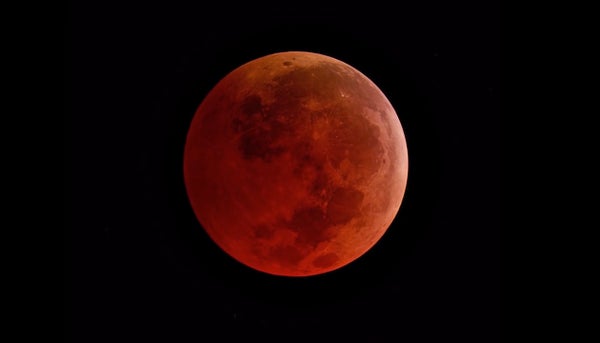On the evening of Sunday, January 20, the most stunning celestial light show over the continental U.S. will actually be a shadow—the Earth’s, in fact, sweeping across the nearside of the moon in a total lunar eclipse. For a shadow, it will be quite bright: Before a potential audience of nearly three billion people, the moon will gradually transform into a glowing copper-colored orb, tinted by sunlight bouncing off and passing through the air in our planet’s dense atmosphere. The same optical effect turns Earth’s skies red at dawn and dusk. For a brief time on Sunday the entire visible face of the moon will bask in what is literally an out-of-this-world sunset.
And this is more than just a pretty picture. There is rich science and history in this spectacle, too: Looking at that rusty shadow’s curved edge sweeping across the lunar landscape, one can surmise from first principles—as the ancient Greeks did—that our planet is round, any and all theories of a flat Earth be damned.
On supporting science journalism
If you're enjoying this article, consider supporting our award-winning journalism by subscribing. By purchasing a subscription you are helping to ensure the future of impactful stories about the discoveries and ideas shaping our world today.
Lunar eclipses take place cyclically, on nights when the moon passes through the shadow of our planet backlit by the sun. Most, however, are less-than-ideal affairs in which just a fraction of the moon encounters the Earth’s deepest shadow (or “umbra”) or instead traverses in whole or in part the “penumbra”—a softer shadow that surrounds the umbra like a nebulous halo. Total lunar eclipses only happen when Earth’s shadow entirely engulfs the moon’s face, and are relatively rare compared with their partial and penumbral counterparts—after this weekend the next one will not occur until May 26, 2021. The reason for their rarity is the moon’s orbit, which is tilted some 5 degrees off-kilter from Earth’s orbital plane, or ecliptic; if the two were perfectly aligned, a total lunar eclipse would occur monthly, each time the moon was full. No one knows for sure, but that skewed orbit is likely a relic from eons ago, when the moon first formed in the fiery aftermath of a collision between our embryonic planet and a Mars-size interloper. Just something to think about the next time you watch Earth’s shadow wax and wane across our nearest neighbor.
But what really makes this weekend’s eclipse noteworthy is how easy it should be to see: Weather permitting, it will be visible in its entirety to all of North and South America (as well as parts of western Europe and northwestern Africa)—and in the Americas its timing happens to align with socially acceptable circadian rhythms. Viewed from the U.S. east coast the moon will enter Earth’s umbra just a few minutes after 10:30 P.M., with the full lunar disk falling wholly into shadow for slightly over an hour, beginning at 11:41 P.M. (meaning one need not burn the midnight oil just to catch a glimpse of the event at its peak). Viewers farther west will have even earlier favorable local viewing times. And fortunately the eclipse is also taking place on the eve of the Martin Luther King, Jr., holiday, when many Americans have the day off from work or school—so feel free to stay up late!
Furthermore, the moon will be very high in the midwinter sky for the continental U.S., far from the horizon (where architecture, light pollution and low-lying clouds might otherwise spoil the view). According to New York City meteorologist Joe Rao, the Big Apple last had such a favorable viewing geometry in 1797, and another total lunar eclipse will not appear as high in the city’s skies until far-off 2113.
Where will you be when the moon grows dark and ruddy this Sunday? Outside, I hope, looking up. Don’t miss it!
